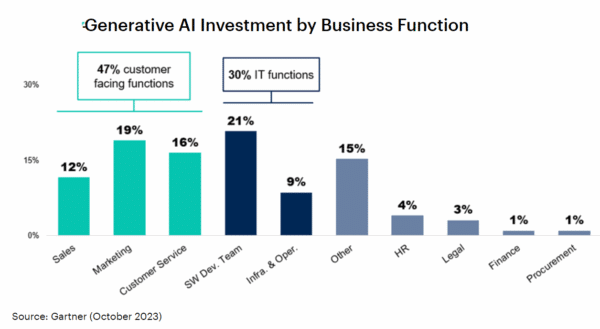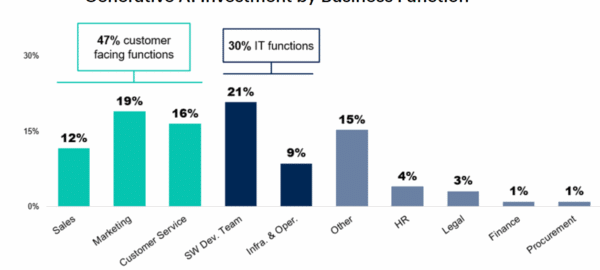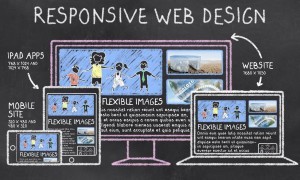The CMO of Unanet explains what it took to implement AI with her team. The secret sauce: Education, experimentation and a clear AI policy.
Everybody’s talking about all the latest AI developments, but there’s a better, more pragmatic question to ask about it: How do you implement AI in your marketing organization?
That’s the question we asked Carrie Mahon, CMO for Unanet, which provides ERP and CRM solutions for government contractors, architecture, engineering, construction and professional services. Mahon, who has been CMO for four years, led the implementation of AI for her team of 25 marketing professionals.
(Interview has been edited for length and clarity.)
Q: Why did you decide to do this?
A: I saw an opportunity. It wasn’t that I felt like we needed to do AI for knowledge’s sake, it was that I saw this great opportunity because I have really talented people. I have very creative people on my team. I have subject matter experts and people who are knowledgeable about government-type programs and like that.
And I was asking, “How can I enhance them and expand their capabilities and just enable them even more?” I saw AI as an opportunity to do that, whether it’s It was productivity improvements. or efficiencies.
I have people doing manual, repetitive tasks and I’d rather have my creative design person building out better and more engaging campaigns and creative than creating seven different sizes of the same ad. I saw that we could get real personalization with AI. We have all this great thought leadership and content. So, how do we personalize the emails to talk about this content? How do we make it real for architects, engineers, construction? And then insights, that was another, big area where I knew I could give my team even more intelligence to make better decisions.
Q: Did you have to get buy-in from other departments?
A: No, it was all within my own team. I knew early on last year, 2023, that this was a really intimidating topic. We have ways of doing things that we’ve always done things. We were always looking for better ways and we wanted to do things smarter and everything, but how? It was a really intimidating topic.
Q: What was your first step?
A: My first thing was education. I have a degree in data analytics, so I was able to do my own education. I took AI courses and read various materials. There are great resources out there like the Marketing AI Institute, Coursera Courses, IBM courses and information I got from our technology partners.
And then I built AI 101 for my staff. That way it wasn’t like me dictating here’s how we’re going to use it. I started with, What is AI? And then, what are some of the things in your everyday life that you’re touching with AI? And then, how can AI impact marketing? It was just educating, teaching resources, sharing.
And then we started, experimenting. I made it so everybody could feel comfortable learning more about it, and then testing it out.
Q: What did you do next?
A: We identified use cases and started piloting tools. I wanted to encourage experimentation so this wasn’t about changing major processes, initially, it was about experimenting with use cases. One of our first AI tools was a generative AI tool. This was a secure, private, internal generative AI tool. Next, I gave everyone on my team access to it, so they could experiment with it, whether it was for preparing an email or just brainstorming.
And people quickly found really unique ways to use it, to enhance what they were doing, and speed things up, and I just encouraged experimenting and then sharing successes and it’s really made people comfortable.
We shared our successes and I think this really helped the implementation. There was a real curiosity about how everyone was using AI and the results they were getting. Having an open dialogue about it was key.
Q: Were there use cases that surprised you?
One example is my events team. We have a user conference and we look at all the survey data from it. We do quantitative data analysis internally but there are a lot of verbatim comments, and they are hard to distill down.
You can do a word cloud, but what can you do with that? The team put the comments into the AI and it found themes and patterns that we hadn’t seen before. We grew that into six or seven key findings that informed our strategy along with the quantitative data. We wouldn’t have gotten that on our own. It just breathed life into the quantitative data and helped us build a better conference.
Q: How long was that education phase?
A: We started in April of last year and it’s still going on. We review new technologies when they come out. This is a journey we’re going to keep going on, keep learning. There are new resources that come out,
Q: When you rolled the AI out for your whole team how was that different than what you had been doing during the education phase?
A: Once I chose our tools, it was important to me that we took our time implementing them. We rolled out a few at a time, some were teamwide and some were specific to certain roles. But with some different use cases, we needed more training and support from the vendor, who was really helpful.
Q: Was your team aware you were planning on rolling AI out across marketing, or did you start with getting them can get comfortable with it?
A: At first, it was just let’s get comfortable. Then it was, “We have ideas, let’s test them out.” I asked people if there were any unique products they thought we should do a trial or pilot with. We did some head-to-head use cases with two different software to see how they performed. We explored a few products that we couldn’t even get to that pilot stage because they just didn’t meet our internal AI policy and data protection guidelines.
So I was open to new ideas. I was open to us failing and things not working. It was just a learning process through those. And we did it together.

Q: You already had AI policies set up?
A: We did. We worked really closely with IT and our legal counsel to understand what was needed and to provide help. We have really specific guidelines that have been rolled out across the company, and then we always talk about that, with our team as well.
Q: Was it useful to have that policy in advance?
A: Oh, yeah. Having someone an expert from IT or legal to read the fine print on different tools and stuff was absolutely key. And they are super responsive. They know what to look for and they know if a product requires changes to our system whether they’ll work or if we just can’t move forward with it. It was supportive and it was very thoughtful and careful.
Q: You didn’t have to worry about wandering off into a minefield because you already had the map through it.
A: Exactly.
Q: What was your process for finding the right vendor?
A: We had a couple of use cases. We had some content that we used with both cases to see if provided the kinds of output and metrics that we were looking for. We had to see if it could meet our needs technically. Did they offer training and implementation and support? Did they have a good customer experience manager and team there? And then what was their roadmap? Did they have a robust AI roadmap to keep advancing their tool?
Q: What advice would you give to someone who wants to do what you did?
A: Marketing is such a unique function. We have many workflows and so much technology that we’re using. It’s the perfect place for AI technology.
My advice is just don’t be afraid of it. It’s really intimidating. You can get overwhelmed and feel like, well, I’m far behind. I’m never going to be able to learn this, and that’s not true. You can jump in now, find that quick hit use case, test it out, trial it and then formalize it. Maybe it works, if it doesn’t you move on to the next one.
It’s not being afraid and educating your team. Getting them all resources, getting them all comfortable with it. You’ve got to get your team comfortable, keep them educated, let them do trial and error with it and not have to show significant impacts right away.
The other piece of advice I’d give is that every day there’s some new tactical piece of advice on using AI with a particular solution. Or here’s a prompt to use or here’s what you do with these images. There’s all these things.
It’s great to stay up to speed on all the technology and everything, but getting caught up in that next new thing every single day can be really overwhelming, too. It can make you feel like, “Oh my gosh, how do I use this now?” That’s when you have to step back and think about your strategy. What are your goals and your outcome? What are you trying to do? Find those areas where you can be smarter and better, then build a plan and execute on that.
Carrie has a blog post that goes into more detail about this. You can find it here.
The post How to do an AI implementation for your marketing team appeared first on MarTech.
(5)







